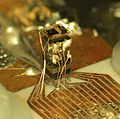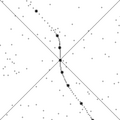Time facts for kids
Time is like a never-ending river that flows from the past, through the present, and into the future. It's how we keep track of when things happen and how long they last. Everything in the universe is always moving forward in time.
To measure time, people use things that repeat regularly. For example, the Earth spinning around creates a new day. The moon going through its different phases helps us track months. And the Earth orbiting the Sun gives us the different seasons of the year.
Long ago, people created calendars to count days in a year. They also used sundials, which show time by the shadow the sun makes. Today, we have very accurate clocks that can measure tiny fractions of a second. The study of how we measure time is called horology.
The main unit for time in science is the second. It's written as s. In math, time is often shown with the letter  . In Einstein's ideas about physics, time and space are connected. You can learn more about this in space-time.
. In Einstein's ideas about physics, time and space are connected. You can learn more about this in space-time.
How We Measure Time
We use different units to measure how long things take. Here are some common ones, from very long to very short:
- 1 millennium = 1,000 years
- 1 century = 100 years
- 1 decade = 10 years
- 1 year = 12 months = 365 days (or 366 days in a leap year)
- 1 month = about 4 weeks = 28 to 31 days
- 1 fortnight = 2 weeks = 14 days
- 1 week = 7 days
- 1 day = 24 hours
- 1 hour = 60 minutes
- 1 minute = 60 seconds
- 1 second = The basic unit of time in the SI
- 1 millisecond = 1/1,000 of a second
- 1 microsecond = 1/1,000,000 of a second
- 1 nanosecond = 1/1,000,000,000 of a second
Tools for Measuring Time
Here are some things people use to measure time:
- Clock
- Hourglass
- Stopwatch
- Sundial
- Circadian rhythm (our body's natural clock)
Related Pages
Images for kids
-
A horizontal sundial in Taganrog.
-
A modern quartz watch from 2007.
-
Small atomic clocks, like this one from 2004, help make GPS more accurate.
-
A scale of time from Jain texts, shown in a special way called logarithmically.
-
The philosopher and psychologist William James.
See also
 In Spanish: Tiempo para niños
In Spanish: Tiempo para niños









